| |
|
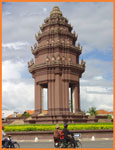
(At the intersection of Norodom and Sihanouk)
The Independence Monument (Vimean Ekareach) was inaugurated in
1958 to celebrate Cambodia’s independence from foreign rule. It
now also serves as a monument to Cambodia’s war dead. It is the
site of celebrations and services on holidays such as Independence
Day and Constitution Day. Trespassing onto the monument is illegal
(sometimes). The best view is from across the street anyway.
(Street 178
& Street 13, next to the Royal Palace - $3.00 - 8:00-5:00,
open everyday)
The distinctive rust-red National Museum next
to the Royal Palace was dedicated by King Sisowath in 1920. Over
5000 objects are on display including Angkorian era statues, lingas
and other artifacts, most notably the legendary statue of the
‘Leper King.’ Though the emphasis is on Angkorian artifacts, there
is also a good collection of pieces from later periods, including
a special exhibition of post-Angkorian Buddha figures. Visiting
the museum after rather than before a trip to Angkor helps lend
context to the Angkorian artifacts. Multi-lingual tour guides
are available. Souvenirs and books available. Photography is limited.
Some guidebooks still mention the museum bats that inhabited the
rafters, unseen in the day but occasionally spectacular as they
left in droves at sunset. In March 2002 the bats left for good,
moving on after renovations to the ceiling. The museum borders
Street 178, aka ‘Artist’s Street’ which is lined with several
art galleries and souvenir shops. The Reyum Gallery is of particular
note, exhibiting the works of contemporary Cambodian artists.
| Royal
Palace and ‘Silver Pagoda’ |
(Sothearos
between Streets 240 & 184 - $3.00/person, $2.00/camera, $5.00/video
cam. Open everyday, 7:30-11:00 / 2:30-5:00)
everyday, 7:30-11:00 / 2:30-5:00)
The Palace buildings and Silver Pagoda are located within the
same walled grounds on Sothearos just off the riverfront. Marking
the approach, the high yellow wall and spired Chan Chaya Pavilion
are the most prominent features from the street. The Royal Palace
was built in 1866 under the French protectorate and King Norodom,
though many of the buildings in the complex were added over the
following decades.
The ‘Silver
Pagoda’ (Wat Preah Keo Morokat) is the city’s most often visited
pagoda because of its display of priceless historical objects.
It draws its name from the over 5000 silver tiles which cover
the floor of the vihear. The vihear serves less as a functioning
temple than a repository for cultural treasures such as the ‘Emerald
Buddha’, innumerable Buddha statues, a Royal Litter and other
objects. Rarely seen in Cambodian pagodas, turn of the century
paintings of the Ramayana epic adorn the outer wall. Fortune tellers
ply their trade in the small temple next to the vihear.
(Intersection
of Street 96 and Norodom Blvd. - $1/person) 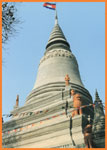
A small hill crowned by an active wat (pagoda) marks the legendary
founding place of the Phnom Penh. The hill is the site of constant
activity, with a steady stream of the faithful trekking to the
vihear, shrines and fortune tellers on top, and a constellation
of vendors, visitors and motodups at the bottom. Elephant rides
available. The legend of the founding of Wat Phnom is tied to
the beginnings of Phnom Penh. Legend has it that in 1372 Lady
Penh (Yea Penh) fished a floating Koki tree out of the river.
Inside the tree were four Buddha statues. She built a hill (‘phnom’
means ‘hill’) and a small temple (wat) at what is now the site
of what is now known as Wat Phnom. Later, the surrounding area
became known after the hill (Phnom) and its creator (Penh), hence
‘Phnom Penh.’ The current temple was last rebuilt in 1926. The
large stupa contains the remains of King Ponhea Yat (1405-1467)
who moved the Khmer capital from Angkor to Phnom Penh in 1422.
Look for the altar of Lady Penh between the large stupa and the
vihear. She is said to be of particular help to women. Wat Phnom
is the busiest pagoda in town the night of Chinese/Vietnamese
New Year’s Eve.
| Choeung
Ek Memorial (The Killing Fields) |
(15 km southwest
of Phnom Penh - Take Monireth 8.5 km past the bridge at Street
271) From 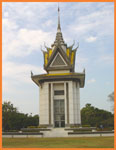 April
17, 1975 until January 7, 1979, the ultra-Communist Khmer Rouge
(i.e. Red Khmer) regime, led by Pol Pot, controlled the whole
of Cambodia. Under the Khmer Rouge regime the country was known
as ‘Democratic Kampuchea.’ During the short reign of the Khmer
Rouge, between one million and two and a half million Cambodians
perished, some killed outright, others dying from disease, malnutrition,
neglect and mistreatment. Many of the dead ended up in various
‘killing fields’ that can be found scattered across the country.
The killing fields were essentially ad hoc places of execution
and dumping grounds for dead bodies. The memorial at Choeung Ek
just outside Phnom Penh was an orchard and a Chinese cemetery
prior to 1975. During the Khmer Rouge regime it became one of
the killing fields - this particular killing field is the site
of the brutal executions of more than 17,000 men, women and children,
most of whom first suffered through interrogation, torture and
deprivation in the S-21 Prison (Toul Sleng) in Phnom Penh. Choeung
Ek is now a group of mass graves and a memorial stupa containing
thousands of skulls. It’s about a 20-40 minute drive from the
center of Phnom Penh. There are guides available at the site,
and a small souvenir shop. For sake of historical context, combine
your trip to Choeung Ek with a visit to Toul Sleng Genocide Museum. April
17, 1975 until January 7, 1979, the ultra-Communist Khmer Rouge
(i.e. Red Khmer) regime, led by Pol Pot, controlled the whole
of Cambodia. Under the Khmer Rouge regime the country was known
as ‘Democratic Kampuchea.’ During the short reign of the Khmer
Rouge, between one million and two and a half million Cambodians
perished, some killed outright, others dying from disease, malnutrition,
neglect and mistreatment. Many of the dead ended up in various
‘killing fields’ that can be found scattered across the country.
The killing fields were essentially ad hoc places of execution
and dumping grounds for dead bodies. The memorial at Choeung Ek
just outside Phnom Penh was an orchard and a Chinese cemetery
prior to 1975. During the Khmer Rouge regime it became one of
the killing fields - this particular killing field is the site
of the brutal executions of more than 17,000 men, women and children,
most of whom first suffered through interrogation, torture and
deprivation in the S-21 Prison (Toul Sleng) in Phnom Penh. Choeung
Ek is now a group of mass graves and a memorial stupa containing
thousands of skulls. It’s about a 20-40 minute drive from the
center of Phnom Penh. There are guides available at the site,
and a small souvenir shop. For sake of historical context, combine
your trip to Choeung Ek with a visit to Toul Sleng Genocide Museum.
| Toul
Sleng Genocide Museum (S-21) |
(Corner of
Street 113 & Street 350 - $2.00 - Open everyday, including
holidays, 8AM-5PM - 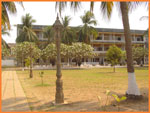 Closed
for lunch) Closed
for lunch)
Prior to 1975, Toul Sleng was a high school. When the Khmer Rouge
came to power it was converted into the S-21 prison and interrogation
facility. Inmates were systematically tortured, sometimes over
a period of months, to extract confessions, after which they were
executed at the killing fields of Choeung Ek. S-21 processed over
17,000 people, seven of whom survived. The building now serves
as a museum, a memorial and a testament to the madness of the
Khmer Rouge regime. Much has been left in the state it was when
the Khmer Rouge abandoned it in January 1979. The prison kept
extensive records, leaving thousands of photos of their victims,
many of which are on display. Paintings of torture at the prison
by Vann Nath, a survivor of Toul Sleng, are also on display. The
museum’s famous and controversial ‘skull map’ is no longer on
display. 
| The
Land Mine Museum, Siem Reap |
Siem Reap,
Cambodia; “Welcome to the Land Mines Museum” reads the sign. Here,
off a 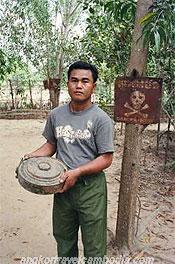 bumpy,
dusty, unsealed road, a few short kilometres from the World Heritage
ruins of Angkor Wat and the construction boom of luxury hotels
in the city of Siem Reap, the past, present and sadly future of
landmines in Cambodia is on display. bumpy,
dusty, unsealed road, a few short kilometres from the World Heritage
ruins of Angkor Wat and the construction boom of luxury hotels
in the city of Siem Reap, the past, present and sadly future of
landmines in Cambodia is on display.
The Land Mine Museum, opened in 1999, consists of a simple corrugated
iron building. Its director, the quiet and unassuming Mr Aki Ra
is a former child soldier of the Khmer Rouge and Vietnamese armies.
Aki Ra, along with his fellow conscripts were forced to lay the
anti-personal devices that covered Cambodia. As an adult, he worked
with the United Nations in the early 1990’s to detect and clear
the mines that until only 10 years ago, surrounded the now tourist
packed grounds of Angkor Wat.
This clearing exercise is far from complete as it is estimated
that 6 million mines remain in the soil of Cambodia. These uncleared
mine fields are primarily located along the Thai/Cambodian border,
and it is here that Aki Ra regularly journeys to continue this
dangerous work.
Killed by Land Mines
Local villages are still regularly maimed or killed by landmines
that come with “manufactured in” labels reading China, Russia,
US, Vietnam and Germany and date stamps from the 1940’s to the
1970’s. The devices have proven to be remarkably resilient, remaining
in active condition many decades after they were first placed
in the ground.
When Aki Ra moved to the region in the late 1990’s, it was an
isolated and lonely rural landscape. The local village of 500
that has grown up around the museum is a testament to Aki Ra’s
efforts in not only clearing the mines, but in educating his neighbors
on mine awareness, safety and first aid.
Despite its simple structure, the museum is a total success in
its aim to raise awareness of the devastating affects of anti-personal
devices. As first Aki Ra and then an English volunteer leads us
through the museum displays, the sickening variety of ways to
maim or kill with these devises becomes more apparent. In the
manufacture, design and placement of landmines, we humans have
thought of everything. 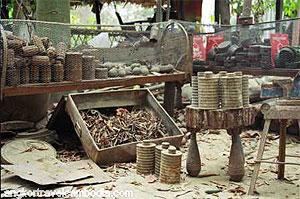
From the technique
of laying mines in water, causing increased damage to the body
by the imploding water, to the lightweight plastic construction
of later models that are both cheaper and easier to carry. The
Claymore mines that are designed to spray ball bearings in a specific
direction coming conveniently labeled with the instruction “Front
facing enemy”. Most of the mines have been designed to destroy
a specific bodypart rather than to kill. This strategy to construction
ensures a more effective strike against the enemy, an injured
soldier is a greater burden than a dead one.
Learning Languages
If visitors doubt the impact of the mines on display, the human
reminder is ever present by the handful of child amputee victims
that live at the museum. A very practical program has been put
in place to provide these children with much needed assistance.
The museum supports them to go to the local school as well as
providing them with English/Japanese lessons courtesy of the international
volunteers. While the museum can house and care for 8 to 9 kids
at a time, the regular rotation of students back to their farms
and families ensures as many as possible can be saved from a life
of street beggars.
Upon meeting Aki Ra and learning of both his horrendous wartime
experiences (depicted in both story and paintings throughout the
museum) and his continuing dangerous mine clearing activities,
you are left in no doubt how remarkable this young man really
is. Having lost his parents during the dark days of the Khmer
Rouge rule, it is amazing that he survived the starvation, cruelty
and danger that engulfed Cambodia during this era. His current
land mine clearing activities defy belief.
Several times a month, for up to 5 days at a time, he works without
sophisticated detection or safety equipment, usually solo, clearing
mines on the Thai/Cambodia border. Using nothing more than his
foot and a stick, he locates and then detonates by hand up to
30 mines per day.
It would be
usual to associate museums with the preservation and recording
of significant historical events. What sets the Land Mine Museum
apart is that the displays are, (& there is no other word
for it) “fresh”!.
Learn
More
The Land Mine
Museum is located 4km south of Ankor Wat and 2km South of
the city of Siem Reap, on the Angkor Wat Road.
The museum, is privately owned and operated, it does not receive
any government funding.
No entry fee is charged, however donations are gratefully accepted.
The museum will not appear in local tourist literature, therefore
best to refer to the following website for details.
|
|